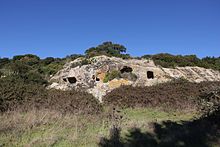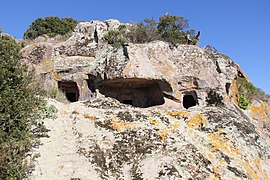Sas Arzolas de Goi
The five Domus de Janas of the necropolis of Sas Arzolas de Goi (three are accessible) are located in the steep Trachy Hill , a few hundred meters from Nughedu Santa Vittoria in the province of Oristano in Sardinia , with a view of Lake Omodeo .
The prenuragic necropolis comes from the Ozieri culture (3200–2800 BC) and was in use until the Eneolithic (2400–1800 BC). The multi-cell domus with anteroom, main and secondary chambers preserve prehistoric artistic reliefs depicting the Neolithic deities. Four hypogea are grouped on the slope, the fifth is about 20.0 meters away on the front of a rock.
Bull heads with ears and horns are carved in relief at the entrance and on a column of grave I. The horns at the entrance are convex and have a width of 0.54 m. The domus consists of an antechamber in which there are traces of red paint. On the right side of the entrance to the main chamber is a carved column. In the main chamber there is another column, in the lower part a cornice and in the upper part some representations of bulls (taurine protomes). The horns are 0.48 m wide and cut as a bas-relief.
The grave II has a longitudinal orientation, consisting of an antechamber and two chambers with secondary chambers. Here the traces of red color are more intense. There is a hearth in the middle of the bottom of the front chamber. The access to the second chamber is provided with a frame. The chamber has straight walls decorated with red paint and the roof of a hut carved out of the rock, imitating a board. The walls are red and half-pillars surround the false windows with no color. In addition, crosses are visible that come from an unknown time. On the left wall is the access door to another small chamber.
The chambers in grave III are rectangular. The antechamber has a door framed by grooves on the three sides in the rear wall. The large, rectangular, wide grave chamber has three approximately 20 centimeters high (similar to that in Çatalhöyük understood as beds) platforms in body size. One is on the right, two on the back wall. The left of the “beds” has a deepened step.
Graves IV and V are visible from the road but inaccessible and are about 14 m away to the southeast. Tomb V is interesting because it shows steps carved into the rock below the entrance.
- Sas Arzolas de Goi
See also
literature
- Giuseppa Tanda: L'arte delle domus de janas nelle immagini di Ingeborg Mangold , Sassari, Chiarella, 1985, p. 26, 37, 114, fig. 4th
- Giuseppa Tanda: La tomba n.2 di Sas Arzolas de Goi a Nughedu S. Vittoria (Oristano) , in Sardinia Antiqua. Studi in onore di Piero Meloni in occasione del suo settantesimo compleanno, Cagliari, Edizioni della Torre, 1992, pp. 75-82, figg. 1-5`
- Jürgen E. Walkowitz: The megalithic syndrome. European cult sites of the Stone Age (= contributions to the prehistory and early history of Central Europe. Vol. 36). Beier & Beran, Langenweißbach 2003, ISBN 3-930036-70-3 .
- Ruth Whitehouse: The Rock-Cut Tombs of the Central Mediterranean. In: Antiquity 46, 1972, ISSN 0003-598X , pp. 275-281.
Web links
- Description (Italian)
- Description (Italian)
- Video
Coordinates: 40 ° 5 '52.4 " N , 8 ° 56' 50.7" E




